To frost-proof your solar water heater, you'll need to implement several key strategies. Start by properly insulating all exposed pipes and components with high-quality materials. Consider installing a heat tracing system to prevent freezing in essential areas. The drain-back method is highly effective, automatically emptying collectors when temperatures drop. Antifreeze solutions can also provide protection, but require regular maintenance. Verify your circulation pumps are set to activate automatically in cold conditions. For rooftop systems, pay attention to proper orientation and tilt for peak performance. Regular inspections and maintenance are vital to keep your system running smoothly. By exploring these methods further, you'll discover the best approach for your specific setup.
Understanding Frost Risks
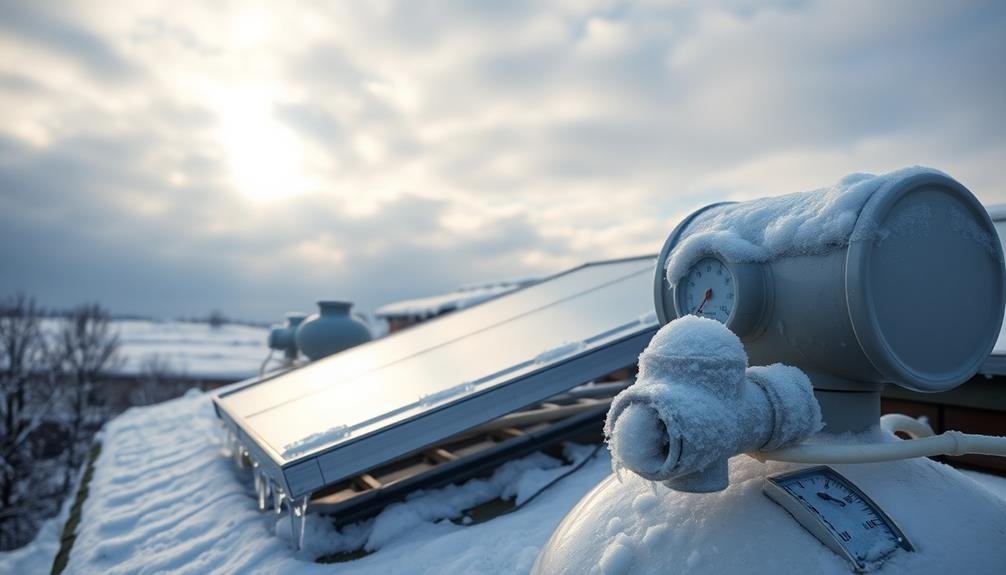
Frost poses a significant threat to solar water heaters, potentially causing extensive damage and costly repairs. When water freezes, it expands, which can crack pipes, burst collectors, and damage other components of your solar heating system.
It's essential to grasp the specific risks your system faces to implement effective frost-proofing measures. You'll need to evaluate your local climate and the frequency of freezing temperatures. Even in warmer regions, occasional cold snaps can catch you off guard.
Pay attention to the design of your solar water heater, as some systems are more vulnerable to frost than others. Flat plate collectors, for instance, are generally more susceptible to freezing than evacuated tube collectors.
The location of your system also plays a role. Rooftop installations may be more exposed to cold air and wind chill, increasing the risk of freezing.
Additionally, assess the insulation of your pipes and storage tank. Poorly insulated components can freeze even when temperatures are above freezing due to heat loss. By understanding these frost risks, you'll be better equipped to choose and implement the most appropriate frost-proofing methods for your solar water heater.
Insulation Techniques
One of the most effective ways to protect your solar water heater from frost damage is through proper insulation. You'll want to focus on insulating both the collector and the piping system. For the collector, consider using a transparent insulating material like polycarbonate sheets or aerogel. These materials allow sunlight to pass through while reducing heat loss.
For your piping system, use high-quality foam insulation sleeves designed for outdoor use. Make sure you cover all exposed pipes, paying extra attention to joints and bends where heat loss is most likely to occur. Don't forget to insulate valves and fittings as well.
Here's a quick guide to insulation materials and their effectiveness:
| Material | R-Value per inch | Moisture Resistance | Cost | Durability |
|---|---|---|---|---|
| Fiberglass | 2.2-2.7 | Poor | Low | Good |
| Polyurethane | 6.3 | Excellent | High | Excellent |
| Aerogel | 10-14 | Excellent | Very High | Excellent |
| Foam rubber | 3-4 | Good | Medium | Good |
| Mineral wool | 3-3.3 | Excellent | Medium | Excellent |
Remember to check your insulation regularly for signs of wear or damage. Replace any deteriorated sections promptly to maintain top-notch frost protection for your solar water heater.
Heat Tracing Systems
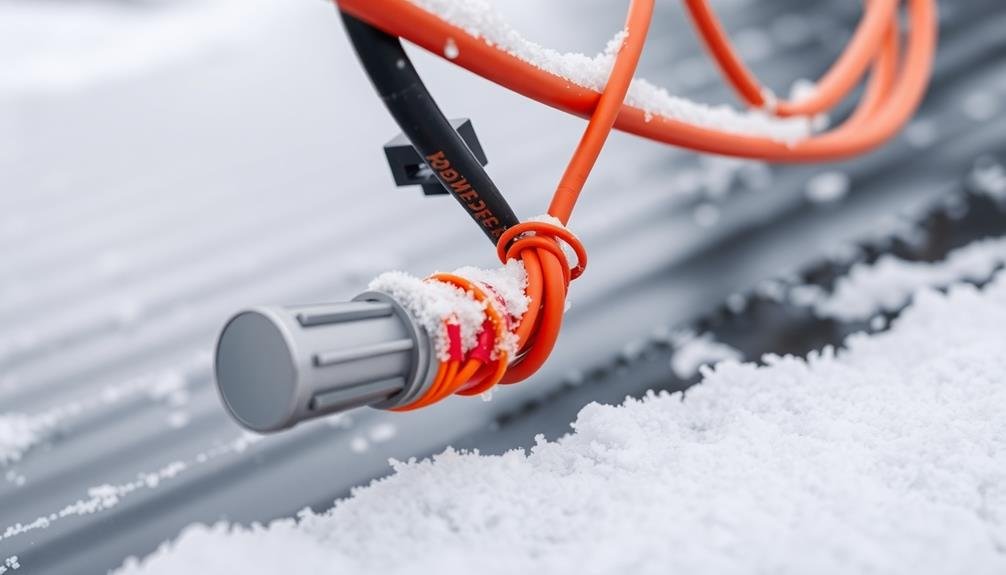
Heat tracing systems offer an effective solution to prevent freezing in your solar water heater pipes.
You'll find various types available, including self-regulating cables, constant wattage cables, and mineral insulated cables, each with its own installation and maintenance requirements.
When considering a heat tracing system, you'll need to weigh its energy efficiency against your climate needs and overall system design.
Types of Tracing Systems
For protecting your solar water heater from freezing, various heat tracing systems are available. These systems can be broadly categorized into electrical and steam-based tracing.
Electrical heat tracing systems include self-regulating cables, constant wattage cables, and mineral insulated cables. Self-regulating cables automatically adjust their heat output based on surrounding temperatures, making them energy-efficient and low-maintenance. Constant wattage cables provide a fixed heat output along their length, suitable for maintaining consistent temperatures. Mineral insulated cables offer high temperature resistance and durability, ideal for harsh environments.
Steam-based tracing systems use steam or hot water to maintain pipe temperatures. They're often used in industrial settings and can be more cost-effective for large-scale applications. You'll find jacketed systems, where pipes are enclosed in a steam-filled jacket, and external tracing, where steam lines run parallel to the main pipe.
When choosing a tracing system for your solar water heater, consider factors like your climate, system size, and energy costs.
You'll also need to decide between parallel and series circuits, which affect installation complexity and maintenance requirements. Consult with a professional to determine the most suitable tracing system for your specific setup.
Installation and Maintenance
Once you've selected the appropriate heat tracing system for your solar water heater, proper installation and maintenance are key to guaranteeing its effectiveness.
Begin by carefully reading the manufacturer's instructions and gathering all necessary tools and materials. Install the heat tracing cable along the pipes, making sure it's in direct contact with the surface. Secure the cable using approved methods, such as heat-resistant tape or cable ties.
For self-regulating cables, connect them to a dedicated circuit with the correct voltage and amperage. Constant wattage cables require a thermostat for temperature control. Install the power connection kit and end seal according to the manufacturer's guidelines. Always use a ground fault circuit interrupter (GFCI) for safety.
Regularly inspect your heat tracing system for signs of damage or wear. Check for loose connections, frayed wires, or damaged insulation. Test the system before each winter season to verify it's functioning correctly. Clean any debris from the cables and surrounding areas to prevent overheating.
Keep detailed records of installation, maintenance, and any repairs performed. This will help you track the system's performance and identify any recurring issues.
Replace aging components as needed to maintain superior frost protection for your solar water heater.
Energy Efficiency Considerations
Energy efficiency is a critical factor when choosing and implementing a heat tracing system for your solar water heater. When selecting a heat tracing system, consider self-regulating cables that adjust their power output based on ambient temperature. These cables consume less energy during milder conditions, reducing overall electricity usage.
Opt for a heat tracing controller with advanced features like temperature sensing and weather forecasting capabilities. This allows the system to activate only when necessary, preventing unnecessary energy consumption.
Additionally, choose insulation materials with high R-values to minimize heat loss and decrease the workload on your heat tracing system.
Consider implementing a zoning strategy, where you divide your solar water heating system into separate sections. This approach allows you to heat trace only the most vulnerable areas, reducing energy waste.
Don't forget to regularly maintain and inspect your heat tracing system to guarantee peak performance and energy efficiency.
Lastly, explore the possibility of powering your heat tracing system with excess solar energy from your panels. This can greatly reduce or eliminate the need for grid electricity, making your frost protection method more sustainable and cost-effective in the long run.
Drain-Back Method
The drain-back method offers a simple yet effective way to protect your solar water heater from frost damage.
When temperatures drop, the system automatically drains water from the collectors back into an indoor tank, preventing freezing.
While this approach is reliable and low-maintenance, it requires careful installation to guarantee proper drainage and may limit your placement options for solar collectors.
How It Works
A drain-back system offers an effective method to protect your solar water heater from frost damage. When the system isn't actively heating water, it automatically drains all the fluid from the collectors and exposed pipes back into a reservoir tank inside your home. This simple yet ingenious design eliminates the risk of freezing in cold weather.
Here's how it works: When your system's pump activates, it pushes water from the reservoir up through the collectors. As the water circulates, it's heated by the sun and returns to your storage tank.
Once the pump shuts off, gravity takes over. All the water in the collectors and outdoor piping flows back down into the reservoir, leaving nothing to freeze.
You'll need to verify your collectors and pipes are properly sloped to allow for complete drainage. The reservoir must also be large enough to hold all the water from the system.
While drain-back systems are highly effective, they do require more powerful pumps to overcome the initial head pressure when refilling the collectors. However, this additional energy consumption is often offset by the system's reliability and low maintenance needs.
Benefits and Drawbacks
While drain-back systems offer excellent freeze protection, they come with their own set of advantages and disadvantages.
On the plus side, you'll benefit from a simple, reliable design that automatically drains water from the collectors when the pump stops. This eliminates the need for antifreeze, reducing maintenance costs and environmental concerns. Drain-back systems also prevent overheating in summer, as the water simply drains away when it gets too hot.
However, there are drawbacks to keep in mind. You'll need to install the storage tank below the collectors, which may limit placement options in your home. The system requires a more powerful pump to overcome the height difference and push water back up to the collectors. This increased pump size leads to higher electricity consumption and potentially more noise.
Additionally, the piping must be carefully sloped to guarantee proper drainage, which can complicate installation. In some cases, you might need larger diameter pipes to accommodate the drain-back function.
Despite these challenges, many homeowners find that the freeze protection and low maintenance benefits outweigh the drawbacks, making drain-back systems a popular choice in colder climates.
Antifreeze Solutions
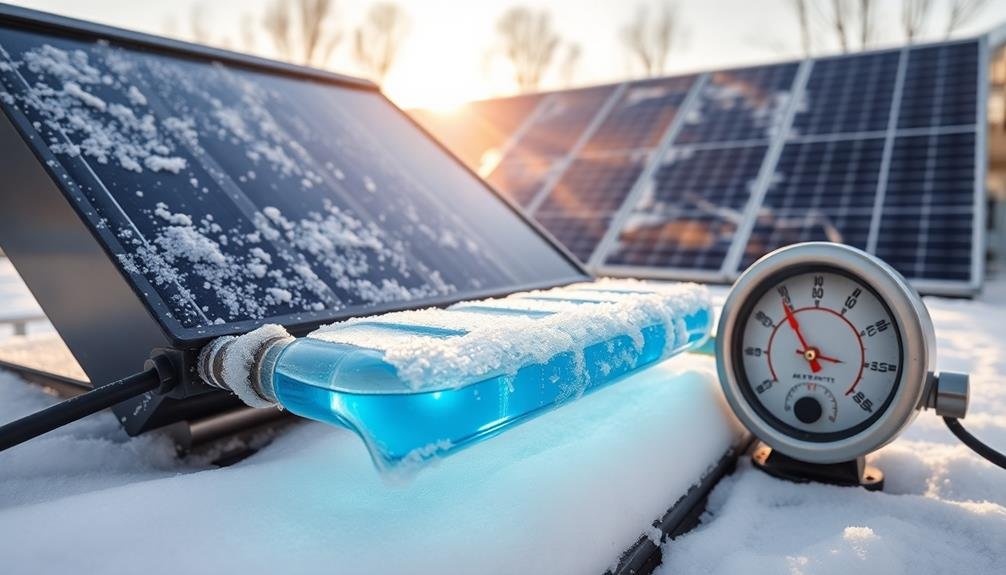
For maximum protection against freezing, antifreeze solutions are an important component in solar water heater systems. These solutions circulate through the collector and heat exchanger, transferring heat to your water supply while preventing freezing in cold temperatures. The most common antifreeze used is propylene glycol, a non-toxic substance that's safe for residential use.
When choosing an antifreeze solution, consider these factors:
- Freezing point: Verify the solution's freezing point is well below your area's lowest expected temperature.
- Boiling point: A higher boiling point prevents the solution from vaporizing in extreme heat.
- Corrosion resistance: Look for solutions with corrosion inhibitors to protect your system's components.
- Longevity: Choose a solution that maintains its effectiveness for several years to minimize maintenance.
You'll need to periodically check the antifreeze concentration and pH levels to maintain peak performance.
It's vital to use only food-grade antifreeze specifically designed for solar water heaters, as automotive antifreeze can be toxic and damage your system.
Remember to have a professional install and maintain your antifreeze solution to guarantee proper function and safety.
Roof-Mounted Heater Considerations
When installing a roof-mounted solar water heater, you'll need to take into account several essential factors to guarantee its effectiveness and longevity.
First, verify your roof can support the additional weight of the system, including the filled water tank. You may need to reinforce the roof structure if it's not sturdy enough.
Consider the angle and orientation of your roof. Ideally, the solar panels should face south in the Northern Hemisphere and north in the Southern Hemisphere. The ideal tilt angle is typically equal to your latitude, but a range between 30-45 degrees is generally acceptable.
Assess your roof's exposure to sunlight throughout the day. Avoid areas shaded by trees, chimneys, or nearby buildings. You'll want to maximize sun exposure for maximum heating efficiency.
Don't forget about maintenance access. Leave enough space around the system for regular inspections and repairs. This includes clear paths for piping and electrical connections.
Lastly, check local building codes and homeowners' association rules. Some areas have specific requirements for roof-mounted systems, including aesthetic considerations or structural limitations.
Obtaining necessary permits before installation is vital to avoid potential legal issues down the line.
Proper Pipe Positioning
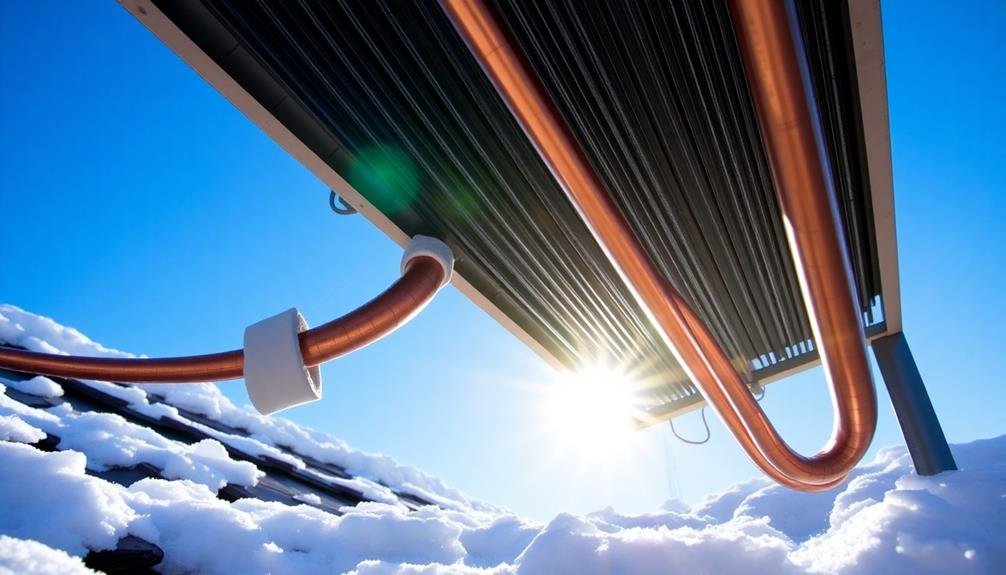
Positioning your solar water heater pipes correctly is essential for ideal performance and frost protection.
You'll want to guarantee your pipes are sloped downwards towards the storage tank, allowing water to drain naturally when the system isn't operating. This prevents water from sitting in the pipes and freezing during cold spells.
Insulate all exposed pipes thoroughly, using high-quality materials designed for outdoor use.
Pay special attention to joints and bends, as these areas are particularly vulnerable to heat loss and freezing. Consider using heat tape on pipes in extremely cold climates for added protection.
To maximize your solar water heater's frost resistance, follow these key steps:
- Install pipes inside the building's insulated envelope whenever possible
- Use flexible piping to minimize the number of joints and potential leak points
- Implement a drain-back system that empties pipes when not in use
- Install temperature sensors to trigger automatic draining when freezing conditions are detected
Automated Freeze Protection Controls
Your solar water heater's automated freeze protection controls employ sensors to detect when temperatures approach freezing.
These sensors trigger circulation pumps to activate, moving warm water through the system to prevent ice formation.
You'll find that this automatic process safeguards your solar heating equipment without requiring manual intervention during cold snaps.
How Controls Detect Freezing
Automated freeze protection controls in solar water heaters rely on sophisticated sensors to detect freezing conditions. These sensors continuously monitor various environmental factors to anticipate and prevent frost damage to your system.
The control system typically uses a combination of:
- Temperature sensors: Placed at critical points in the solar collector and piping, these sensors measure the water temperature and ambient air temperature.
- Flow sensors: These detect the movement of fluid through the system, guaranteeing proper circulation during freeze protection modes.
- Pressure sensors: Monitoring system pressure helps identify potential ice formation or blockages.
- Weather data integration: Some advanced systems connect to local weather forecasts to predict freezing conditions.
When sensors detect temperatures approaching freezing, the control system activates protective measures.
It'll either drain the collector or circulate warm water from the storage tank. Some systems use antifreeze solutions, while others employ heat tape or electric heating elements.
You'll find that modern control systems often include remote monitoring capabilities, allowing you to check your system's status and receive alerts on your smartphone.
This feature guarantees you're always aware of potential freezing issues, even when you're away from home.
Activating Circulation Pumps Automatically
Once the control system detects potential freezing conditions, it springs into action by activating circulation pumps. These pumps start moving warm water from your storage tank through the collector panels, preventing ice formation. The automated process guarantees your solar water heater remains protected even when you're away or asleep.
Modern freeze protection systems offer various pump activation strategies:
| Strategy | Description |
|---|---|
| Timer-based | Activates pumps at set intervals |
| Temperature-differential | Compares collector and tank temps |
| Flow rate control | Adjusts pump speed for best protection |
| Zoned circulation | Targets specific at-risk areas |
| Smart learning | Adapts to weather patterns over time |
You'll want to choose a system that best fits your climate and solar setup. In milder regions, a simple timer-based approach might suffice. For areas with harsh winters, consider a more sophisticated temperature-differential or smart learning system. Don't forget to regularly maintain your pumps and check that freeze protection controls are functioning correctly. This proactive approach will help guarantee your solar water heater operates efficiently year-round, even during the coldest months.
Circulation Pumps for Frost Prevention
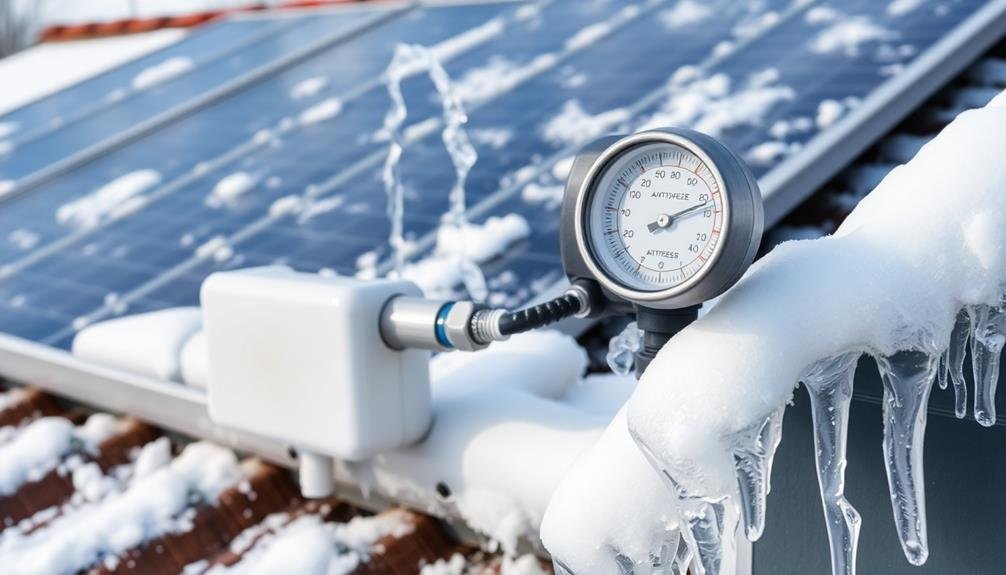
Circulation pumps play an essential role in frost-proofing your solar water heater.
These pumps work by continuously moving water through the system, preventing it from freezing in the pipes and collectors. When temperatures drop close to freezing, the pump activates, circulating warm water from your storage tank through the exposed components.
To maximize the effectiveness of circulation pumps for frost prevention:
- Choose the right pump size: Verify your pump can handle the volume of your system and overcome friction losses in the piping.
- Install a reliable controller: Use a controller that accurately monitors temperature and activates the pump when needed.
- Insulate exposed pipes: Minimize heat loss by properly insulating all external piping.
- Regular maintenance: Check your pump and controller annually to verify they're functioning correctly.
Nighttime Draining Strategies
Draining your solar water heater at night can be an effective strategy to prevent frost damage. This method involves emptying the collector and exposed pipes when temperatures drop below freezing. You'll need to install a drain-back system, which allows water to flow back into a storage tank or reservoir when the circulation pump stops.
To implement this strategy, you'll need:
- A storage tank below the collector level
- Sloped pipes for proper drainage
- An automatic controller to manage the process
The controller monitors outdoor temperatures and activates the draining process when needed. When temperatures rise, it refills the system. You can also opt for a manual system, but it requires more attention and effort on your part.
Benefits of nighttime draining include:
- Reduced energy consumption compared to continuous circulation
- Lower risk of pipe bursts
- Minimal antifreeze use
However, consider these drawbacks:
- Initial installation costs
- Potential for air locks in the system
- Slightly reduced efficiency due to daily refilling
To maximize this strategy's effectiveness, guarantee proper pipe slopes, use high-quality valves, and regularly maintain your system.
With careful implementation, nighttime draining can be a reliable frost-proofing method for your solar water heater.
Solar Collector Orientation Tips
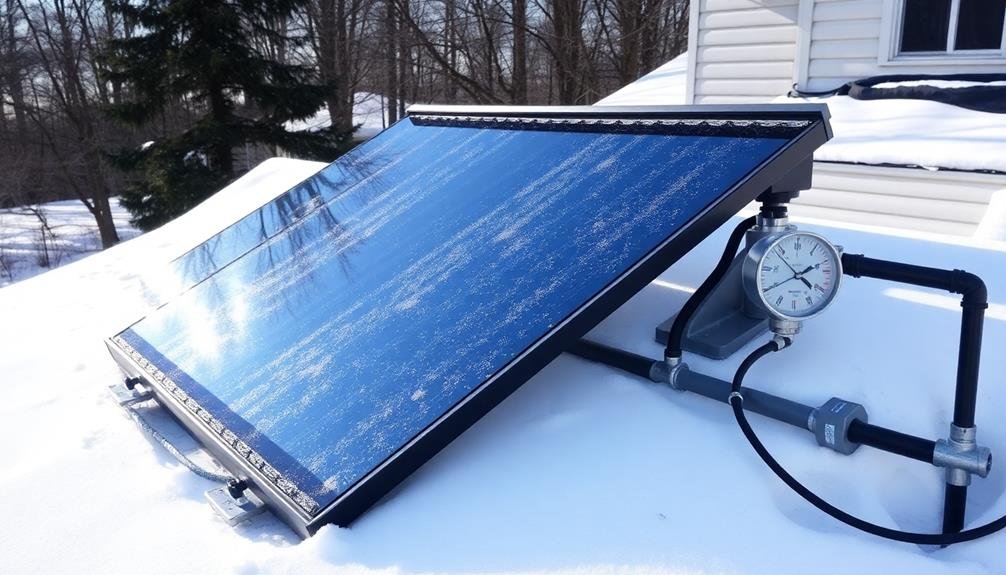
While nighttime draining strategies focus on protecting your system, proper solar collector orientation is key to maximizing its efficiency.
You'll want to guarantee your collectors are positioned to capture the most sunlight throughout the year, especially during winter months when frost is a concern.
To enhance your solar collector's orientation:
- Face it true south in the Northern Hemisphere (or true north in the Southern Hemisphere) for maximum exposure to the sun's path.
- Adjust the tilt angle to match your latitude for year-round efficiency, or add 15 degrees for winter enhancement.
- Avoid shading from nearby structures, trees, or other obstacles that could reduce sunlight absorption.
- Consider a tracking system for ideal sun-following capabilities, though this may increase maintenance needs.
Regular Maintenance for Frost Resistance
Regular upkeep is essential for maintaining your solar water heater's frost resistance. Start by inspecting your system's insulation annually, replacing any damaged or deteriorated sections.
Check all pipes, valves, and fittings for signs of wear or leaks, and repair or replace them promptly. Don't forget to examine the collector panels for cracks or damage that could allow moisture to penetrate.
Clean the collector panels regularly to guarantee maximum efficiency and heat absorption. Remove any debris, dust, or snow that might accumulate on the surface.
Test the antifreeze solution in your system annually, and replace it if it's degraded or diluted. This step is vital for preventing freezing in sub-zero temperatures.
Verify that your system's freeze protection mechanisms, such as drain-back systems or heat exchangers, are functioning correctly. Test automatic drain valves to confirm they open when temperatures approach freezing.
If you have a pump circulation system, confirm it's operating as intended during cold weather. Finally, schedule a professional inspection every few years to catch any issues you might've missed and to receive expert advice on improving your system's frost resistance.
Frequently Asked Questions
Can I Use My Solar Water Heater During Winter in Extremely Cold Climates?
You can use your solar water heater in extremely cold climates, but it's challenging. You'll need to take precautions like insulating pipes, using antifreeze solutions, and installing freeze protection valves to prevent damage from freezing temperatures.
How Often Should I Inspect My Solar Water Heater for Frost Damage?
You should inspect your solar water heater for frost damage at least twice a year. Check it before winter starts and after the cold season ends. Don't forget to examine pipes, collectors, and insulation for any signs of damage.
What's the Average Cost to Frost-Proof a Solar Water Heater System?
You'll typically spend between $200 to $1,000 to frost-proof your solar water heater system. Costs vary based on system size, location, and chosen method. DIY options are cheaper, while professional services offer more thorough protection.
Are There Any Government Incentives for Frost-Proofing Solar Water Heaters?
You'll find that government incentives for frost-proofing solar water heaters are limited. While there are tax credits for installing solar systems, specific frost-proofing measures aren't typically covered. Check with your local energy office for potential regional programs.
Can I Retrofit an Existing Solar Water Heater With Frost Protection Features?
Yes, you can retrofit your existing solar water heater with frost protection features. You'll need to add insulation, heat tape, or antifreeze solutions to the system. It's best to consult a professional for proper installation and safety.
In Summary
You've now got a toolkit to protect your solar water heater from frost damage. Remember, it's essential to implement these methods before winter hits. Don't wait until it's too late. Whether you choose insulation, heat tracing, or antifreeze solutions, take action now. Regular maintenance and smart orientation can also make a big difference. By frost-proofing your system, you'll guarantee it keeps working efficiently year-round, saving you money and hassle in the long run.

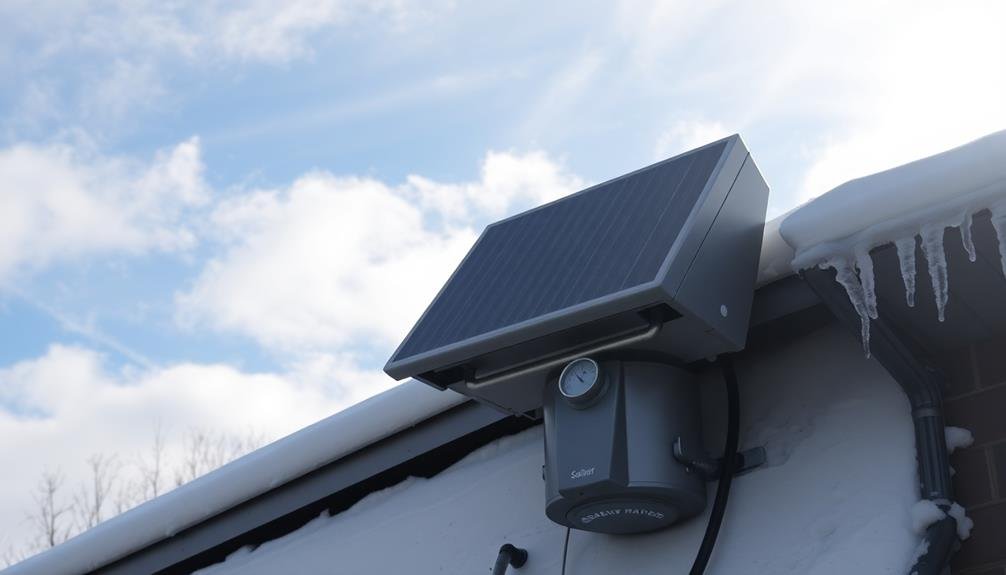

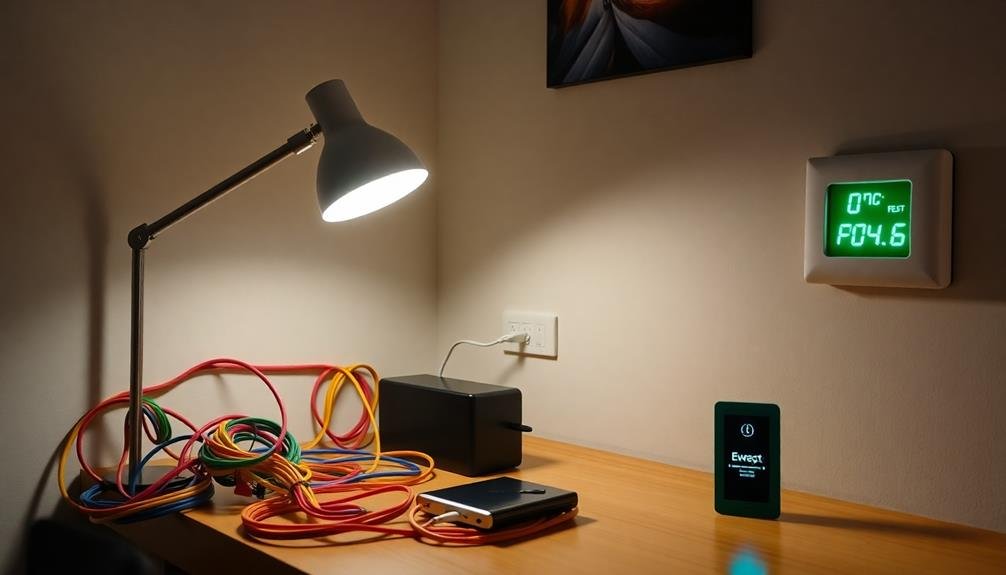
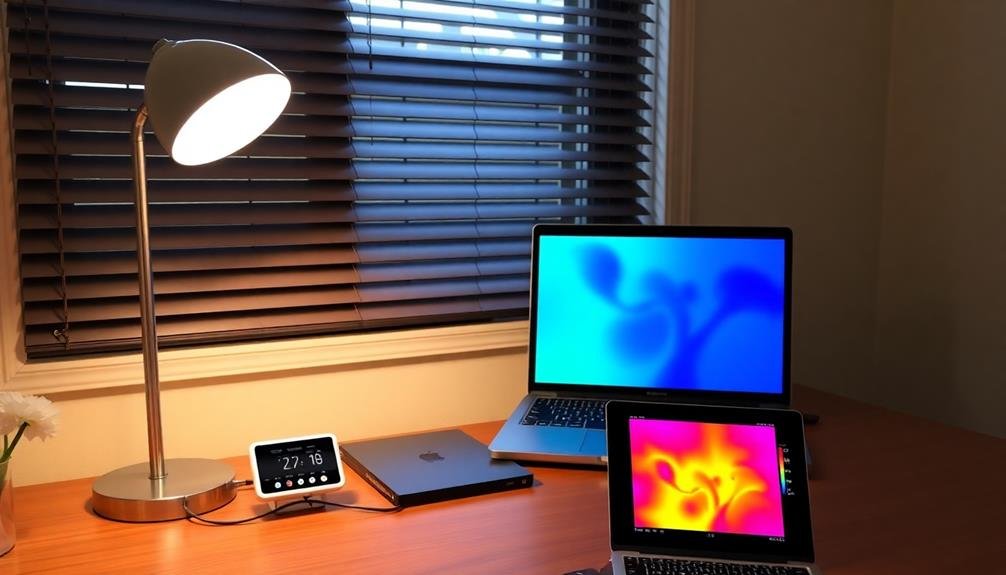
Leave a Reply